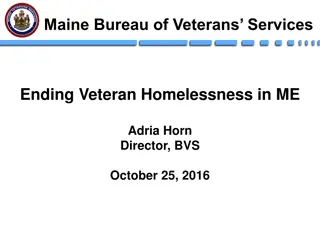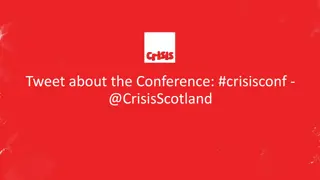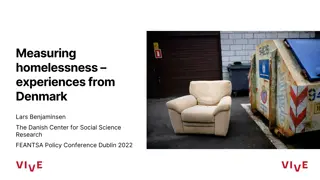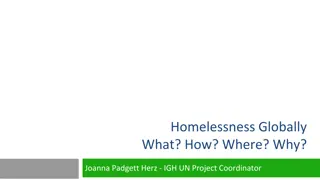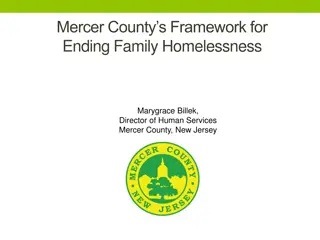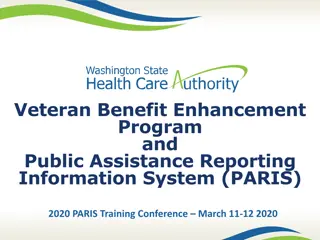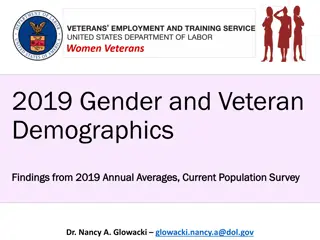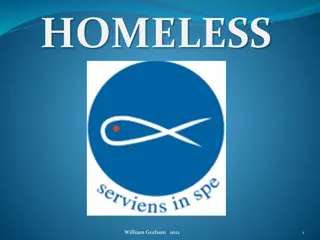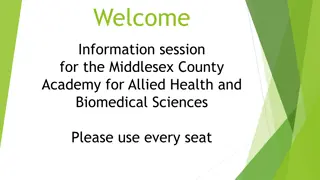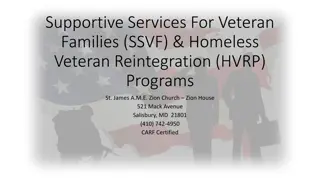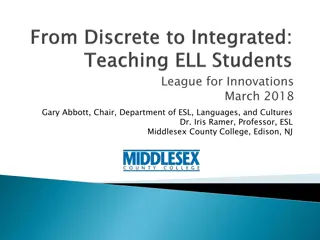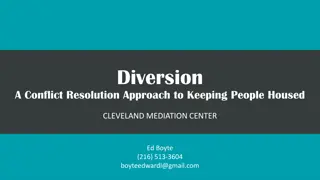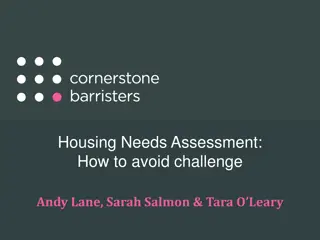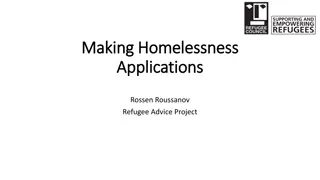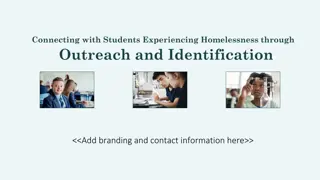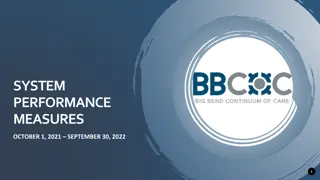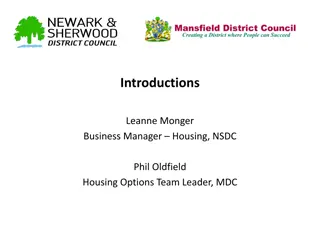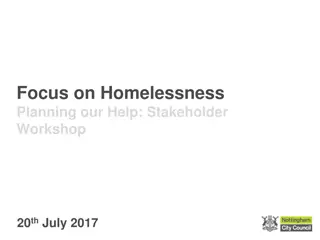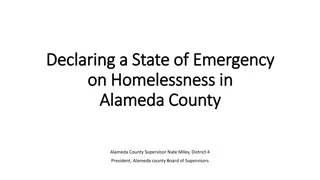Achieving and Maintaining Functional Zero: Middlesex County's Approach to Ending Veteran Homelessness
Middlesex County's innovative approach to achieving and maintaining functional zero in veteran homelessness is highlighted through the Veterans Housing Assistance Program (VHAP) and partnerships with service providers. By emphasizing uniqueness, flexibility, and sustainability, the county has made significant progress in serving all veterans and preventing homelessness. The concept of functional zero and its implications are explored during the National Coalition for Homeless Veterans Annual Conference in Washington, D.C.
Download Presentation

Please find below an Image/Link to download the presentation.
The content on the website is provided AS IS for your information and personal use only. It may not be sold, licensed, or shared on other websites without obtaining consent from the author. Download presentation by click this link. If you encounter any issues during the download, it is possible that the publisher has removed the file from their server.
E N D
Presentation Transcript
ACHIEVING & MAINTAINING FUNCTIONAL ZERO National Coalition for Homeless Veterans Annual Conference, Washington, D.C. May 31st, 2018 Presenters: Bridget S. Kennedy, Director of Social Work Services Doug Breen, Veteran Services Coordinator Henry Busby, Veterans Housing Specialist Middlesex County Board of Chosen Freeholders Ronald G. Rios, Director Charles E. Tomaro, Deputy Director Kenneth Armwood, Charles Kenny, Leslie Koppel, Shanti Narra, Blanquita B. Valenti Middlesex County (NJ) Department of Community Services Office of Human Services
Introductions Presenters: Bridget, Doug, & Henry Workshop Participants - Please give us: Your Name City/County/Region & its Relative Size Organization State What is your status vis- -vis FUNCTIONAL ZERO? Achieved Not Started Working on Other Beginning 2
The Middlesex County (NJ) Story The Veterans Housing Assistance Program (VHAP) Middlesex County Homeless Trust Fund Freeholder Director s Commitment: Our Hero Uniqueness Established Late 2012; Kicked into gear August 2013 Emergency Fund held by local VFW Post: Another Hero Began partnerships with the 2 SSVF Providers serving our County Morphed into Functional Zero 3
Uniqueness Serve all veterans, including National Guard & Reservists, regardless of where they served. Flexibility Creativity Veteran-centered Believe in Prevention Housing Locator Services Insist on Veteran s Sustainability, including not aiding any veteran with a rental subsidy expect under extraordinary circumstances Not Case Managers (CMs), but have local resource knowledge to aid veteran s SSVF or HUD-VASH CMs 4
Functional Zero 1st heard of it here 3 years ago; and knew it was BIG! What does it mean to you? Several Examples of Definitions: Community Solutions: easily digestible definition of functional zero: At any point in time, the number of veterans experiencing sheltered and unsheltered homelessness in a community will be no greater than the average monthly housing placement rate for veterans experiencing homelessness in that community. 5
Functional Zero Several Examples of Definitions: HUD Supported Zero 16: functional zero is reached when the number of veterans experiencing homelessness within a community is less than the average number of veterans being connected with permanent housing each month. In achieving this measure, a community has demonstrated the system and capacity to quickly and efficiently connect people with housing and ensure that veteran homelessness within the community will be rare, brief, and non-recurring. 6
Functional Zero Several Examples of Definitions: Collins Dictionary, New Word Suggestion: Functional zero recognizes that there will always be people or veterans who are homeless or at risk of becoming homeless, but as long as these people can be identified and re- housed quickly and effectively, the homeless rate will be effectively or functionally zero. Submitted By: RobertG - 01/03/2017 7
Functional Zero Confusion, Controversy, Scariness What it really means applying the KISS Principle 8
Strategies to End Veteran Homelessness 1. Get State & Local Leaders to Publicly Commit to and Coordinate Efforts on Ending Homelessness a. Find a Hero or Heroine 2. Implement a Housing First System Orientation and Response a. Substance use, criminal history, or motivation should not be obstacles in successful tenancy b. With the correct case management/engagement 9
Strategies to End Veteran Homelessness 3. Implement a Coordinated Entry System a. A common assessment process performed consistently across partners b. A data-driven approach to prioritizing people with the most significant needs c. Provide assistance with paperwork, identifications, appointments, and other critical steps to get into housing 10
Strategies to End Veteran Homelessness 4. Set and Meet Short and Long-Term Goals by Using all Available Resources Effectively a. The efficient deployment and full utilization of targets programs, i.e. HUD-VASH and SSVF and ensure they are participating in the community s coordinated entry system b. Disseminate best practices and remove barriers throughout the system c. Identify resources to serve Veterans who cannot be served through these targeted programs d. Push systems to perform with maximum efficiency 11
Strategies to End Veteran Homelessness 5. Improve transitional housing performance and consider adopting different models and/or converting or reallocating resources into supportive housing a. Provide permanent housing opportunities to people as quickly as possible b. Transitional housing should only be used as a bridge to permanent housing c. Communities should seek to help Veterans currently residing in transitional housing move rapidly into permanent housing 12
Strategies to End Veteran Homelessness 6. Engage and Support Private Landlords as Partners a. Partnerships with private market landlords is critical b. In high-cost, low-vacancy markets, the challenge of finding available rental units is great. c. Undertaking landlord engagement strategies, e.g. recruitment campaigns and risk mitigation, are important 13
Strategies to End Veteran Homelessness 7. Identify and be accountable to all veterans experiencing homelessness (or who might become homeless in the future) a. Locate and identify EVERY Veteran or Veteran family in need of assistance, and track their progress from initial engagement to housing placement in real time. b. Create a MASTER LIST! (We ll have whole separate discussion on this.) c. Track person-level data to better monitor progress and be accountable to housing outcomes. 14
Strategies to End Veteran Homelessness 8. Conduct Coordinated Outreach and Engagement Efforts a. Ensure that outreach efforts are comprehensive and cover a full geographic area & multiple settings within it. b. Coordinate with other systems, e.g. law enforcement, hospitals & emergency departments, prisons & jails, libraries, job centers, etc. c. Partner with Health Care for the Homeless (HCH) and Projects for Assistance in Transition from Homeless (PATH) grantees to improve care coordination and optimize resources. d. All outreach should be person-centered and emphasize building rapport and trust as a means of helping people obtain housing with appropriate services. 15
Strategies to End Veteran Homelessness 9. Increase Connections to Employment a. Collaborate with Workforce Investment Boards (WIBs) to provide seamless referrals between the CoC, VA medical Center, and workforce systems. b. Some communities have projects funded by the Department of Labor s Veterans Employment & Training Service (DOL-VETS), a Homeless Veteran s Reintegration Program, or a generic Re-entry Program for those returning from a correctional setting. c. Communities should also work directly with employers to encourage them to hire Veterans who have experienced homelessness. 16
Strategies to End Veteran Homelessness 10. Coordinate With Legal Services Organizations To Solve Legal Needs a. Veterans experiencing homelessness often have unmet legal needs, e.g. preventing avoidable evictions, navigating outstanding warrants, expunging criminal records, securing targeted and mainstream benefits, high garnered child support payments, etc. b. Community should coordinate with legal services to address individual and systemic legal needs. 17
Strategies to End Veteran Homelessness Our Two Additional Strategies 11. Direct Veterans to Resources Which Assist With Other Possible Veteran Benefits a. Maintain working relationship with VA Healthcare and Benefits Personnel. b. Maintain a database of VA Forms for Distribution. c. Apply online for Military Personnel Records d. Assist in upgrading Character of Services; increasing VA Benefits, etc. 18
Strategies to End Veteran Homelessness Our Two Additional Strategies 12. Use of SOAR to help those veterans who might qualify for SSI/SSDI a. Have in-house SOAR Leader to evaluate Veterans who might be eligible for SSI/SSDI Benefits. b. Maintain a list of local SOAR Trained Representative to Assist with Applications 19
Criteria for Achieving Functional Zero 1. The community has identified all veterans experiencing homelessness 2. The community provides shelter immediately to any veteran experiencing unsheltered homelessness who wants it 3. The community only provides service-intensive transitional housing in limited instances 4. The community has capacity to assist veterans to swiftly move into permanent housing 5. The community has resources, plans, and system capacity in place should any veteran become homeless or be at risk of homelessness in the future 20
Criteria for Achieving Functional Zero Veterans have quick access to permanent housing a) Some communities have been able to create housing assistance delivery systems for Veterans so effective that the average length of time from homelessness to permanent housing is as short as 30 days. b) We recognize that this length of time may be challenging for other communities, particularly in more competitive and higher cost rental housing markets. We believe that a benchmark achievable by most communities for the average time from the identification of Veterans homelessness to permanent housing entry is 90 days or less. 21
Criteria for Achieving Functional Zero Maintaining an active list (Master list) A community must have an active list (commonly referred to as a by-name list) that identifies all homeless Veterans, including those who are unsheltered, as well as, in sheltered locations e.g., transitional housing, emergency shelter, etc. The community must be able to demonstrate the list is updated or refreshed at least monthly. The list may be populated by other data sources, such as HOMES, HMIS, or other comparable databases. This list is also updated at least monthly to reflect accurate status if verification shows that a person on the active list is not a Veteran. 22
Our Achievements & Components On October 24, 2016, Freeholder Director Ronald Rios received a letter from then First Lady Michelle Obama congratulating Middlesex County on the extraordinary achievement of ending veteran homelessness. [Note the misnomer.] 23
Our Achievements & Components Had & continue to have Local Government Support (both theoretically & monetarily). Partnerships: SSVF Providers Middlesex County Housing Continuum VA Health & Homeless Services of Care Committee (MCHC3), our local Middlesex County Veterans Advisory Continuum of Care (CoC) Council (MCVAC) Cadre of local Realtors & Landlords Local VFW Posts, American Legion (especially those interested in assisting Posts, & other Veteran groups Veterans) Community, in general Mainstream Resource Providers, including SOAR-trained staff 24
Our Achievements & Components Coordinated Assessment for both Sheltering & Permanent Supportive Housing Required Documentation: DD214/Veteran Verification Release of Information: general & for HMIS Income Verification & Need Personal History, especially Housing, Employment, & Health Status (latter to ascertain if have an eligible disability) HMIS Information & VHAP Application Landlord Information & Documents 25
Our Achievements & Components Typical Homeless Vet Scenario Typical Prevention Scenario Monthly Case Conference Calls 26
Our Achievements & Components Importance of Case Management: Absolutely necessary! Doug & Henry are not Case Managers (so we depend on SSVF & HUD- VASH Case Managers, but also offer them advice from time to time). Why BSK is the Queen of Mean when it comes to Vets with Vouchers 27
Functional Zero: Our Progress to Date Since December 6, 2013 238 veterans have been permanently housed through our program. An additional 203 veterans have been prevented from homelessness within the same timeframe. There are also 12 veterans who refused housing, moved out of county or choose to reside in a transitional housing setting. Average length of time to house a homeless veteran: 22 days Median length of time to house a homeless veteran: 10 days 28
Maintenance, Difficulties and Overcoming Barriers Master List (Pros, Cons, Fusions) Adding/Deleting, Maintaining & Coordinating with Partners in an Ever- Shifting Environment Relationship & Coordination with Your CoC Community Case Management/Service Navigation Absolutely necessary, but woefully inadequate from our experience (Ex: HUD-VASH clients behind in rent) 29
Maintenance, Difficulties and Overcoming Barriers Case Conferencing Data Collection & Interface Landlord Engagement 30
Maintenance, Difficulties and Overcoming Barriers Dearth of Affordable Housing (in certain areas/regions) Importance of Landlord Engagement, especially in this environment Veteran Preferences: how to avoid pit falls Utilization of Vouchers (national, state, and local), including creation of Past Credit History, Criminal Background, Lack of Income Shared Living Opportunities 31
Maintenance, Difficulties and Overcoming Barriers Sustainability Emergency Housing Opportunities Understanding & Adapting to Changes Thinking Outside the Box Treat each Case Individually Synthesizing, While Staying True 32
Mantras We will have your back, but we will not carry your pack! Semper Gumby Rare, brief, and one time: That s the vision that is driving our work And that s for everyone. For Veterans. For families with children. For people with disabilities. For youth and young adults. For single adults. - Matthew Doherty, USICH Executive Director, March 3, 2018, NAEH s National Conference on Ending Family and Youth Homelessness in Los Angeles. 34
RESOURCES for your Tool Box National Coalition for Homeless Veterans (NCHV), whose conference this is. United States Interagency Council on Homelessness (USICH) (usually includes links to all Federal Departments, e.g. VA, HUD, HHS, Labor, etc.) 35
CONTACT INFORMATION Doug Breen: Email: doug.breen@co.middlesex.nj.us Phone: 732-745-4051 Henry Busby: Email: henry.busby@co.middlesex.nj.us Phone: 732-745-5918 Bridget S. Kennedy, MSW: Email: bridget.kennedy@co.middlesex.nj.us Phone: 732-745-4228 36


